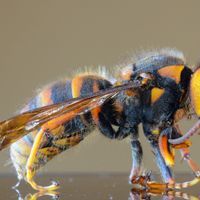Login
Subscribeinsect behavior

Ant Pupae Feed Adults, Larvae with Secreted Liquid
Viviane Callier | Nov 30, 2022 | 4 min read
The molting fluid of ant pupae functions as “metabolic currency” in the ant colony and may have enabled the evolution of eusociality.

Do Invertebrates Have Emotions?
Natalia Mesa, PhD | May 26, 2022 | 10+ min read
And how do scientists go about answering that question?

Book Excerpt from Sounds Wild and Broken
David George Haskell | May 16, 2022 | 5 min read
In a chapter entitled “Predators, Silence, Wings,” author David George Haskell explores the soundscapes of bygone eras of animal communication.

Evolutionary Ecologist Matthew Gage Dies at 55
Amanda Heidt | Apr 20, 2022 | 3 min read
The University of East Anglia researcher was best known for his contributions to the study of sexual selection, particularly post-copulatory sperm competition.

Mosquitoes Add Bacteria to Water to Help Larvae Grow: Preprint
Natalia Mesa, PhD | Apr 12, 2022 | 4 min read
Pregnant mosquito females deploy the microbe Elizabethkingia to speed larval growth; the larvae, in turn, help the bacteria outcompete other strains.

Virus Alters Caterpillars’ Vision to Trick Them into Climbing
Alejandra Manjarrez, PhD | Mar 25, 2022 | 4 min read
A study finds that a baculovirus that infects cotton bollworm larvae changes the expression of genes involved in light perception, driving them to seek heights that could favor viral transmission.

Termite Brains Anticipate Future Visual Challenges
Chloe Tenn | Feb 1, 2022 | 2 min read
Dampwood termites with the potential to leave the colony have larger optic lobes before ever being exposed to different visual environments, an example of predictive brain plasticity.

Leaping Larvae Intrigue Scientists
Chloe Tenn | Jan 20, 2022 | 6 min read
The Scientist spoke with entomologist Matt Bertone about the characteristics of Laemophloeus biguttatus larvae jumps—a previously unreported behavior in this group of beetles.

Infographic: Animal Embryos Coopt Sound to Survive and Thrive
Amanda Heidt | Nov 1, 2021 | 1 min read
Across the tree of life, animals use sound and other vibrations to glean valuable sensory information about their environments even before they are born.

Embryonic Eavesdropping: How Animals Hear and Respond to Sound
Amanda Heidt | Nov 1, 2021 | 10+ min read
Recent findings buck the traditional idea that embryos are passive agents and instead suggest that by tuning into vibrations, organisms can better prepare to enter the outside world.

Slideshow: How Animal Embryos Eavesdrop on the Outside World
Amanda Heidt | Nov 1, 2021 | 4 min read
Watch and listen to reptiles, amphibians, insects, and birds respond to sound from inside their eggs.

Firefly Tourism Sparks Calls for Sustainable Practices
Asher Jones | Jun 1, 2021 | 5 min read
More and more people are traveling around the world to watch the luminous displays of fireflies, but tourism-related light pollution and habitat degradation threaten to snuff out the insects at some locations.

Drosophila: To Infinity and Beyond
The Scientist Staff | Mar 9, 2021 | 1 min read

Slideshow: Watch Insects in Motion
Amanda Heidt | Mar 1, 2021 | 4 min read
Researchers across disciplines are adopting high-tech tools to better understand the kinematics and behaviors behind insect flight.

Free Fallin’: How Scientists Study Unrestrained Insects
Amanda Heidt | Mar 1, 2021 | 10+ min read
Researchers are pulling from video games, sports broadcasting, meteorology, and even missile guidance technology to better investigate how insects have mastered flight.

Infographic: VR, Radar, and Other Tricks for Studying Insects
Amanda Heidt | Mar 1, 2021 | 1 min read
Researchers are getting creative to understand flight behavior in the fast-moving and tiny animals.

Insects Might Be More Sensitive to Radiation than Thought
Alejandra Manjarrez, PhD | Feb 1, 2021 | 5 min read
A study of bumble bees exposed to levels of radiation equivalent to those existing in Chernobyl hotspots shows that the insects’ reproduction takes a hit.

Researchers Try to Head Off “Murder Hornets” Coming into US
Shawna Williams | May 4, 2020 | 2 min read
Asian giant hornets were found for the first time in Washington State and could reemerge in the spring.

Once Is Enough For Long-Term Memory Formation in Bees
Ruth Williams | May 1, 2020 | 3 min read
Honeybees can remember reward-associated odors three days after a single learning experience.
